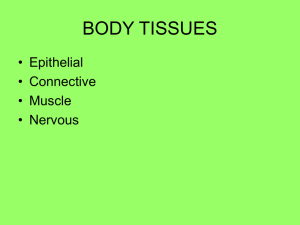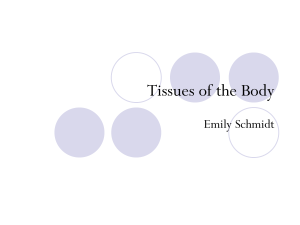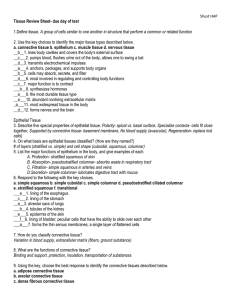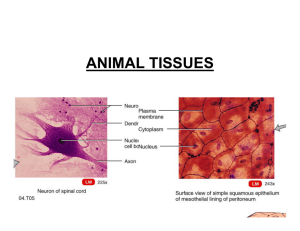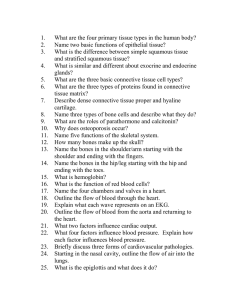Anatomy & Physiology: Tissue Classification Homework
advertisement
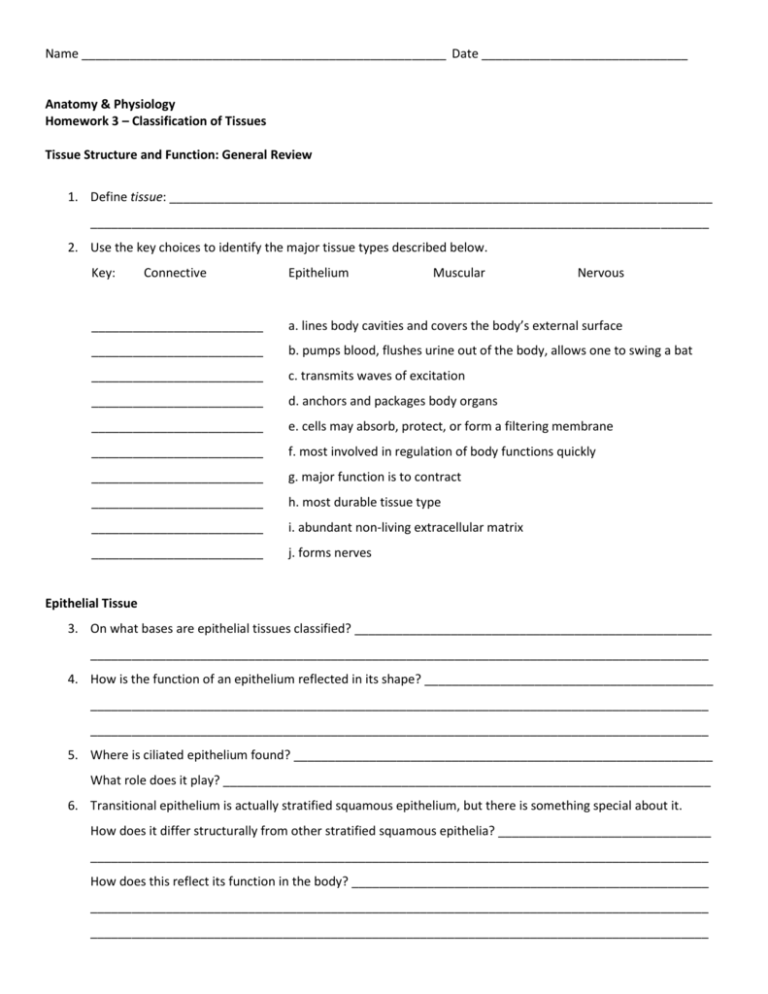
Name _____________________________________________________ Date ______________________________ Anatomy & Physiology Homework 3 – Classification of Tissues Tissue Structure and Function: General Review 1. Define tissue: _______________________________________________________________________________ __________________________________________________________________________________________ 2. Use the key choices to identify the major tissue types described below. Key: Connective Epithelium Muscular Nervous _________________________ a. lines body cavities and covers the body’s external surface _________________________ b. pumps blood, flushes urine out of the body, allows one to swing a bat _________________________ c. transmits waves of excitation _________________________ d. anchors and packages body organs _________________________ e. cells may absorb, protect, or form a filtering membrane _________________________ f. most involved in regulation of body functions quickly _________________________ g. major function is to contract _________________________ h. most durable tissue type _________________________ i. abundant non-living extracellular matrix _________________________ j. forms nerves Epithelial Tissue 3. On what bases are epithelial tissues classified? ____________________________________________________ __________________________________________________________________________________________ 4. How is the function of an epithelium reflected in its shape? __________________________________________ __________________________________________________________________________________________ __________________________________________________________________________________________ 5. Where is ciliated epithelium found? _____________________________________________________________ What role does it play? _______________________________________________________________________ 6. Transitional epithelium is actually stratified squamous epithelium, but there is something special about it. How does it differ structurally from other stratified squamous epithelia? _______________________________ __________________________________________________________________________________________ How does this reflect its function in the body? ____________________________________________________ __________________________________________________________________________________________ __________________________________________________________________________________________ 7. Respond to the following with the key choices. Key: Transitional Simple cuboidal Simple columnar Simple squamous Stratified squamous _______________________________ a. best suited for areas subject to friction _______________________________ b. most suited for rapid diffusion _______________________________ c. tubules of the kidney _______________________________ d. stretches _______________________________ e. lines the small and large intestines _______________________________ f. found in the air sacs of the lungs Connective Tissue 8. What is the makeup of the matrix in connective tissues? ____________________________________________ __________________________________________________________________________________________ __________________________________________________________________________________________ 9. How are the functions of connective tissue reflected in its structure? __________________________________ __________________________________________________________________________________________ __________________________________________________________________________________________ 10. Using the key, choose the best response to identify the connective tissues described below. Key: Adipose connective tissue Reticular connective tissue Areolar connective tissue Hyaline cartilage Dense fibrous connective tissue Osseous tissue _____________________________ a. attaches bones to bones and muscles to bones _____________________________ b. forms your hip bone _____________________________ c. a soft packing tissue with a jellylike matrix _____________________________ d. forms the larynx and the costal cartilages of the ribs _____________________________ e. firm matrix heavily invaded with fibers; appears glassy _____________________________ f. matrix hard; provides levers for muscles to act on _____________________________ g. insulates against heat loss; provides reserve fuel Muscle Tissue 11. The terms and phrases in the key relate to the muscle tissues. For each of the muscle tissues, select the terms or phrases that characterize it, and write the corresponding letter of each term on the answer line. Key: a. striated f. voluntary k. attached to bones b. branching cells g. involuntary l. c. spindle-shaped cells h. one nucleus m. in wall of stomach d. cylindrical cells i. many nuclei n. moves limbs e. active during birth j. forms heart walls o. arranged in sheets intercalated discs Skeletal muscle: _______________________________________________________________________ Cardiac muscle: _______________________________________________________________________ Smooth muscle: _______________________________________________________________________ Nervous Tissue 12. In what ways are nerve cells similar to other cells? _________________________________________________ How are they different? ______________________________________________________________________ How does the special structure of a neuron relate to its function? _____________________________________ __________________________________________________________________________________________ 13. Write the name of each tissue type in illustrations a through l. a. ______________________ b. ______________________ c. ______________________ d. ______________________ e. ______________________ f. ______________________ g. ______________________ h. ______________________ i. ______________________ j. ______________________ k. ______________________ l. ______________________

